Use of an Innovative Silage of Agro-Industrial Waste By-Products in Pig Nutrition: A Pilot Study of Its Effects on the Pig Gastrointestinal Microbiota
Abstract
1. Introduction
2. Materials and Methods
2.1. Experimental Design, Diets, and Animal Management
2.2. Digesta Sampling from the Gastrointestinal Tract
2.3. Assessment of Ileal and Caecal Bacterial Diversity Using High-Throughput Sequencing
2.3.1. DNA Extraction
2.3.2. 16S rRNA High-Throughput Sequencing
2.3.3. Bioinformatics Analysis
2.4. Statistical Analysis
3. Results
3.1. Pig Performance
3.2. Influence of IS Supplementation on the Composition of the Gastrointestinal Microbiota
3.2.1. Exp. 1 (Weaned Pigs)
3.2.2. Exp. 2 (Finishing Pigs)
4. Discussion
5. Conclusions
Author Contributions
Funding
Data Availability Statement
Conflicts of Interest
References
- FAOSTAT. Food and Agriculture Organization of the United Nations (FAO) Food and Agriculture Organization of the United Nations Statistical Databases. Available online: https://www.fao.org/faostat (accessed on 1 March 2023).
- Celi, P.; Cowieson, A.J.; Fru-Nji, F.; Steinert, R.E.; Kluenter, A.M.; Verlhac, V. Gastrointestinal functionality in animal nutrition and health: New opportunities for sustainable animal production. Anim. Feed Sci. Technol. 2017, 234, 88–100. [Google Scholar] [CrossRef]
- Belkaid, Y.; Hand, T.W. Role of the microbiota in immunity and inflammation. Cell 2014, 157, 121–141. [Google Scholar] [CrossRef] [PubMed]
- Kamada, N.; Chen, G.Y.; Inohara, N.; Nunez, G. Control of pathogens and pathobionts by the gut microbiota. Nat. Immunol. 2013, 14, 685–690. [Google Scholar] [CrossRef]
- Rowland, I.; Gibson, G.; Heinken, A.; Scott, K.; Swann, J.; Thiele, I.; Tuohy, K. Gut microbiota functions: Metabolism of nutrients and other food components. Eur. J. Nutr. 2018, 57, 1–24. [Google Scholar] [CrossRef] [PubMed]
- Gresse, R.; Chaucheyras-Durand, F.; Fleury, M.A.; Van de Wiele, T.; Forano, E.; Blanquet-Diot, S. Gut microbiota dysbiosis in postweaning piglets: Understanding the keys to health. Trends Microbiol. 2017, 25, 851–873. [Google Scholar] [CrossRef] [PubMed]
- DeGruttola, A.K.; Low, D.; Mizoguchi, A.; Mizoguchi, E. Current understanding of dysbiosis in disease in human and animal models. Inflamm. Bowel. Dis. 2016, 22, 1137–1150. [Google Scholar] [CrossRef]
- Trevisi, P.; Luise, D.; Correa, F.; Bosi, P. Timely Control of Gastrointestinal Eubiosis: A Strategic Pillar of Pig Health. Microorganisms 2021, 9, 313. [Google Scholar] [CrossRef]
- Holman, D.B.; Chenier, M.R. Antimicrobial use in swine production and its effect on the swine gut microbiota and antimicrobial resistance. Can. J. Microbiol. 2015, 61, 785–798. [Google Scholar] [CrossRef]
- Lekagul, A.; Tangcharoensathien, V.; Yeung, S. Patterns of antibiotic use in global pig production: A systematic review. Vet. Anim. Sci. 2019, 7, 100058. [Google Scholar] [CrossRef]
- Zeineldin, M.; Aldridge, B.; Lowe, J. Antimicrobial Effects on Swine Gastrointestinal Microbiota and Their Accompanying Antibiotic Resistome. Front. Microbiol. 2019, 10, 1035. [Google Scholar] [CrossRef]
- Goutard, F.L.; Bordier, M.; Calba, C.; Erlacher-Vindel, E.; Góchez, D.; de Balogh, K.; Benigno, C.; Kalpravidh, W.; Roger, F.; Vong, S. Antimicrobial policy interventions in food animal production in South East Asia. BMJ 2017, 358, j3544. [Google Scholar] [CrossRef]
- Xiong, W.; Sun, Y.; Zeng, Z. Antimicrobial use and antimicrobial resistance in food animals. Environ. Sci. Pollut. Res. Int. 2018, 25, 18377–18384. [Google Scholar] [CrossRef]
- Tiseo, K.; Huber, L.; Gilbert, M.; Robinson, T.P.; Van Boeckel, T.P. Global Trends in Antimicrobial Use in Food Animals from 2017 to 2030. Antibiotics 2020, 9, 918. [Google Scholar] [CrossRef] [PubMed]
- Wallinga, D.; Smit, L.A.M.; Davis, M.F.; Casey, J.A.; Nachman, K.E. A Review of the Effectiveness of Current US Policies on Antimicrobial Use in Meat and Poultry Production. Curr. Environ. Health Rep. 2022, 9, 339–354. [Google Scholar] [CrossRef]
- Ajila, C.M.; Brar, S.K.; Verma, M.; Tyagi, R.D.; Godbout, S.; Valero, J.R. Bio-processing of agro-byproducts to animal feed. Crit. Rev. Biotechnol. 2012, 32, 382–400. [Google Scholar] [CrossRef]
- Lemes, A.C.; Egea, M.B.; de Oliveira Filho, J.G.; Gauterio, G.V.; Ribeiro, B.D.; Coelho, M.A.Z. Biological Approaches for Extraction of Bioactive Compounds From Agro-industrial By-products: A Review. Front. Bioeng. Biotechnol. 2021, 9, 802543. [Google Scholar] [CrossRef] [PubMed]
- Ominski, K.; McAllister, T.; Stanford, K.; Mengistu, G.; Kebebe, E.G.; Omonijo, F.; Cordeiro, M.; Legesse, G.; Wittenberg, K. Utilization of by-products and food waste in livestock production systems: A Canadian perspective. Anim. Front. 2021, 11, 55–63. [Google Scholar] [CrossRef] [PubMed]
- Reguengo, L.M.; Salgaco, M.K.; Sivieri, K.; Marostica Junior, M.R. Agro-industrial by-products: Valuable sources of bioactive compounds. Food Res. Int. 2022, 152, 110871. [Google Scholar] [CrossRef]
- Rauw, W.M.; Rydhmer, L.; Kyriazakis, I.; Overland, M.; Gilbert, H.; Dekkers, J.C.; Hermesch, S.; Bouquet, A.; Gomez Izquierdo, E.; Louveau, I.; et al. Prospects for sustainability of pig production in relation to climate change and novel feed resources. J. Sci. Food Agric. 2020, 100, 3575–3586. [Google Scholar] [CrossRef]
- Kafantaris, I.; Stagos, D.; Kotsampasi, B.; Hatzis, A.; Kypriotakis, A.; Gerasopoulos, K.; Makri, S.; Goutzourelas, N.; Mitsagga, C.; Giavasis, I.; et al. Grape pomace improves performance, antioxidant status, fecal microbiota and meat quality of piglets. Animal 2018, 12, 246–255. [Google Scholar] [CrossRef]
- Nguyen Cong, O.; Taminiau, B.; Pham Kim, D.; Daube, G.; Nguyen Van, G.; Bindelle, J.; Abdulaye Fall, P.; Vu Dinh, T.; Hornick, J.L. Effect of increasing levels of rice distillers’ by-product on growth performance, nutrient digestibility, blood profile and colonic microbiota of weaned piglets. Asian-Australas J. Anim. Sci. 2020, 33, 788–801. [Google Scholar] [CrossRef]
- Tardiolo, G.; Romeo, O.; Zumbo, A.; Di Marsico, M.; Sutera, A.M.; Cigliano, R.A.; Paytuvi, A.; D’Alessandro, E. Characterization of the Nero Siciliano Pig Fecal Microbiota after a Liquid Whey-Supplemented Diet. Animals 2023, 13, 642. [Google Scholar] [CrossRef] [PubMed]
- Sanchez, C.J.; Barrero-Dominguez, B.; Martinez-Miro, S.; Madrid, J.; Banos, A.; Aguinaga, M.A.; Lopez, S.; Hernandez, F. Use of Olive Pulp for Gestating Iberian Sow Feeding: Influence on Performance, Health Status Indicators, and Fecal Microbiota. Animals 2022, 12, 3178. [Google Scholar] [CrossRef] [PubMed]
- Fiesel, A.; Gessner, D.K.; Most, E.; Eder, K. Effects of dietary polyphenol-rich plant products from grape or hop on pro-inflammatory gene expression in the intestine, nutrient digestibility and faecal microbiota of weaned pigs. BMC Vet. Res. 2014, 10, 196. [Google Scholar] [CrossRef]
- Ao, W.; Cheng, M.; Chen, Y.; Sun, J.; Zhang, C.; Zhao, X.; Liu, M.; Zhou, B. Fermented Apple Pomace Improves Plasma Biochemical and Antioxidant Indicators and Fecal Microbiota of Weaned Pigs. Agriculture 2022, 12, 1603. [Google Scholar] [CrossRef]
- Petrotos, K.; Papaioannou, C.; Kokkas, S.; Gkoutsidis, P.; Skoufos, I.; Tzora, A.; Bonos, E.; Tsinas, A.; Giavasis, I.; Mitsagga, C. Optimization of the Composition of a Novel Bioactive Silage Produced by Mixing of Ground Maize Grains with Olive Mill Waste Waters, Grape Pomace and Feta Cheese Whey. AgriEngineering 2021, 3, 868–893. [Google Scholar] [CrossRef]
- Bonos, E.; Skoufos, I.; Petrotos, K.; Giavasis, I.; Mitsagga, C.; Fotou, K.; Vasilopoulou, K.; Giannenas, I.; Gouva, E.; Tsinas, A.; et al. Innovative Use of Olive, Winery and Cheese Waste By-Products as Functional Ingredients in Broiler Nutrition. Vet. Sci. 2022, 9, 290. [Google Scholar] [CrossRef] [PubMed]
- AOAC. Official Methods of Analysis, 18th ed.; Association of Analytical Chemists, AOAC International: Arlington, VA, USA, 2007. [Google Scholar]
- National Research Council. Nutrient Requirements of Swine: Eleventh Revised Edition; The National Academies Press: Washington, DC, USA, 2012; p. 420. [Google Scholar]
- Klindworth, A.; Pruesse, E.; Schweer, T.; Peplies, J.; Quast, C.; Horn, M.; Glockner, F.O. Evaluation of general 16S ribosomal RNA gene PCR primers for classical and next-generation sequencing-based diversity studies. Nucleic Acids Res. 2013, 41, e1. [Google Scholar] [CrossRef]
- Edgar, R.C. UPARSE: Highly accurate OTU sequences from microbial amplicon reads. Nat. Methods 2013, 10, 996–998. [Google Scholar] [CrossRef]
- Lagkouvardos, I.; Joseph, D.; Kapfhammer, M.; Giritli, S.; Horn, M.; Haller, D.; Clavel, T. IMNGS: A comprehensive open resource of processed 16S rRNA microbial profiles for ecology and diversity studies. Sci. Rep. 2016, 6, 33721. [Google Scholar] [CrossRef]
- Reitmeier, S.; Hitch, T.C.A.; Treichel, N.; Fikas, N.; Hausmann, B.; Ramer-Tait, A.E.; Neuhaus, K.; Berry, D.; Haller, D.; Lagkouvardos, I.; et al. Handling of spurious sequences affects the outcome of high-throughput 16S rRNA gene amplicon profiling. ISME Commun. 2021, 1, 31. [Google Scholar] [CrossRef]
- Lagkouvardos, I.; Fischer, S.; Kumar, N.; Clavel, T. Rhea: A transparent and modular R pipeline for microbial profiling based on 16S rRNA gene amplicons. PeerJ 2017, 5, e2836. [Google Scholar] [CrossRef] [PubMed]
- Yoon, S.H.; Ha, S.M.; Kwon, S.; Lim, J.; Kim, Y.; Seo, H.; Chun, J. Introducing EzBioCloud: A taxonomically united database of 16S rRNA gene sequences and whole-genome assemblies. Int. J. Syst. Evol. Microbiol. 2017, 67, 1613–1617. [Google Scholar] [CrossRef] [PubMed]
- Ferrer, P.; Calvet, S.; Garcia-Rebollar, P.; de Blas, C.; Jimenez-Belenguer, A.I.; Hernandez, P.; Piquer, O.; Cerisuelo, A. Partially defatted olive cake in finishing pig diets: Implications on performance, faecal microbiota, carcass quality, slurry composition and gas emission. Animal 2020, 14, 426–434. [Google Scholar] [CrossRef]
- Verge-Merida, G.; Barroeta, A.C.; Guardiola, F.; Verdu, M.; Balart, M.; Font, I.F.M.; Sola-Oriol, D. Crude and acid oils from olive pomace as alternative fat sources in growing-finishing pigs. Animal 2021, 15, 100389. [Google Scholar] [CrossRef]
- Wang, R.; Yu, H.; Fang, H.; Jin, Y.; Zhao, Y.; Shen, J.; Zhou, C.; Li, R.; Wang, J.; Fu, Y.; et al. Effects of dietary grape pomace on the intestinal microbiota and growth performance of weaned piglets. Arch. Anim. Nutr. 2020, 74, 296–308. [Google Scholar] [CrossRef]
- Nessmith, W.B., Jr.; Nelssen, J.L.; Tokach, M.D.; Goodband, R.D.; Bergström, J.R. Effects of substituting deproteinized whey and(or) crystalline lactose for dried whey on weanling pig performance2. J. Anim. Sci. 1997, 75, 3222–3228. [Google Scholar] [CrossRef]
- Kobayashi, Y.; Itoh, A.; Miyawaki, K.; Koike, S.; Iwabuchi, O.; Iimura, Y.; Kobashi, Y.; Kawashima, T.; Wakamatsu, J.; Hattori, A.; et al. Effect of liquid whey feeding on fecal microbiota of mature and growing pigs. Anim. Sci. J. 2011, 82, 607–615. [Google Scholar] [CrossRef]
- De Rodas, B.; Youmans, B.P.; Danzeisen, J.L.; Tran, H.; Johnson, T.J. Microbiome profiling of commercial pigs from farrow to finish. J. Anim. Sci. 2018, 96, 1778–1794. [Google Scholar] [CrossRef]
- Mach, N.; Berri, M.; Estelle, J.; Levenez, F.; Lemonnier, G.; Denis, C.; Leplat, J.J.; Chevaleyre, C.; Billon, Y.; Dore, J.; et al. Early-life establishment of the swine gut microbiome and impact on host phenotypes. Environ. Microbiol. Rep. 2015, 7, 554–569. [Google Scholar] [CrossRef]
- Chen, L.; Xu, Y.; Chen, X.; Fang, C.; Zhao, L.; Chen, F. The maturing development of gut microbiota in commercial piglets during the weaning transition. Front. Microbiol. 2017, 8, 1688. [Google Scholar] [CrossRef] [PubMed]
- Guevarra, R.B.; Hong, S.H.; Cho, J.H.; Kim, B.R.; Shin, J.; Lee, J.H.; Kang, B.N.; Kim, Y.H.; Wattanaphansak, S.; Isaacson, R.E.; et al. The dynamics of the piglet gut microbiome during the weaning transition in association with health and nutrition. J. Anim. Sci. Biotechnol. 2018, 9, 54. [Google Scholar] [CrossRef] [PubMed]
- Choudhury, R.; Middelkoop, A.; Boekhorst, J.; Gerrits, W.J.J.; Kemp, B.; Bolhuis, J.E.; Kleerebezem, M. Early life feeding accelerates gut microbiome maturation and suppresses acute post-weaning stress in piglets. Environ. Microbiol. 2021, 23, 7201–7213. [Google Scholar] [CrossRef]
- Luise, D.; Le Sciellour, M.; Buchet, A.; Resmond, R.; Clement, C.; Rossignol, M.N.; Jardet, D.; Zemb, O.; Belloc, C.; Merlot, E. The fecal microbiota of piglets during weaning transition and its association with piglet growth across various farm environments. PLoS ONE 2021, 16, e0250655. [Google Scholar] [CrossRef] [PubMed]
- Xu, B.; Qin, W.; Xu, Y.; Yang, W.; Chen, Y.; Huang, J.; Zhao, J.; Ma, L. Dietary Quercetin Supplementation Attenuates Diarrhea and Intestinal Damage by Regulating Gut Microbiota in Weanling Piglets. Oxid. Med. Cell Longev. 2021, 2021, 6221012. [Google Scholar] [CrossRef]
- Tapia-Quiros, P.; Montenegro-Landivar, M.F.; Reig, M.; Vecino, X.; Cortina, J.L.; Saurina, J.; Granados, M. Recovery of Polyphenols from Agri-Food By-Products: The Olive Oil and Winery Industries Cases. Foods 2022, 11, 362. [Google Scholar] [CrossRef]
- Louis, P.; Flint, H.J. Diversity, metabolism and microbial ecology of butyrate-producing bacteria from the human large intestine. FEMS Microbiol Lett. 2009, 294, 1–8. [Google Scholar] [CrossRef]
- Amat, S.; Lantz, H.; Munyaka, P.M.; Willing, B.P. Prevotella in Pigs: The Positive and Negative Associations with Production and Health. Microorganisms 2020, 8, 1584. [Google Scholar] [CrossRef]
- Singh, V.; Lee, G.; Son, H.; Koh, H.; Kim, E.S.; Unno, T.; Shin, J.H. Butyrate producers, “The Sentinel of Gut”: Their intestinal significance with and beyond butyrate, and prospective use as microbial therapeutics. Front. Microbiol. 2022, 13, 1103836. [Google Scholar] [CrossRef]
- Holman, D.B.; Brunelle, B.W.; Trachsel, J.; Allen, H.K. Meta-analysis to define a core microbiota in the swine gut. mSystems 2017, 2, e00004-17. [Google Scholar] [CrossRef]
- Gao, Q.; Sun, G.; Duan, J.; Luo, C.; Yangji, C.; Zhong, R.; Chen, L.; Zhu, Y.; Wangdui, B.; Zhang, H. Alterations in gut microbiota improve SCFA production and fiber utilization in Tibetan pigs fed alfalfa diet. Front. Microbiol. 2022, 13, 969524. [Google Scholar] [CrossRef]
- Xu, J.; Xu, R.; Jia, M.; Su, Y.; Zhu, W. Metatranscriptomic analysis of colonic microbiota’s functional response to different dietary fibers in growing pigs. Anim. Microbiome 2021, 3, 45. [Google Scholar] [CrossRef] [PubMed]
- Torres-Pitarch, A.; Gardiner, G.E.; Cormican, P.; Rea, M.; Crispie, F.; O’Doherty, J.V.; Cozannet, P.; Ryan, T.; Lawlor, P.G. Effect of cereal soaking and carbohydrase supplementation on growth, nutrient digestibility and intestinal microbiota in liquid-fed grow-finishing pigs. Sci. Rep. 2020, 10, 1023. [Google Scholar] [CrossRef]
- Raimondi, S.; Musmeci, E.; Candeliere, F.; Amaretti, A.; Rossi, M. Identification of mucin degraders of the human gut microbiota. Sci. Rep. 2021, 11, 11094. [Google Scholar] [CrossRef] [PubMed]
- Jans, C.; Meile, L.; Lacroix, C.; Stevens, M.J. Genomics, evolution, and molecular epidemiology of the Streptococcus bovis/Streptococcus equinus complex (SBSEC). Infect. Genet. Evol. 2015, 33, 419–436. [Google Scholar] [CrossRef]
- Moreno, L.Z.; Matajira, C.E.C.; Gomes, V.T.M.; Silva, A.P.S.; Mesquita, R.E.; Christ, A.P.G.; Sato, M.I.Z.; Moreno, A.M. Molecular and antimicrobial susceptibility profiling of atypical Streptococcus species from porcine clinical specimens. Infect. Genet. Evol. 2016, 44, 376–381. [Google Scholar] [CrossRef]
- Sitthicharoenchai, P.; Burrough, E.R.; Arruda, B.L.; Sahin, O.; Dos Santos, J.G.; Magstadt, D.R.; Pineyro, P.E.; Schwartz, K.J.; Rahe, M.C. Streptococcus gallolyticus and Bacterial Endocarditis in Swine, United States, 2015–2020. Emerg. Infect. Dis. 2022, 28, 192–195. [Google Scholar] [CrossRef] [PubMed]
- Bescucci, D.M.; Moote, P.E.; Ortega Polo, R.; Uwiera, R.R.E.; Inglis, G.D. Salmonella enterica Serovar Typhimurium Temporally Modulates the Enteric Microbiota and Host Responses To Overcome Colonization Resistance in Swine. Appl. Environ. Microbiol. 2020, 86, e01569-20. [Google Scholar] [CrossRef]
- Li, Z.; Zhang, W.; Su, L.; Huang, Z.; Zhang, W.; Ma, L.; Sun, J.; Guo, J.; Wen, F.; Mei, K.; et al. Difference analysis of intestinal microbiota and metabolites in piglets of different breeds exposed to porcine epidemic diarrhea virus infection. Front. Microbiol. 2022, 13, 990642. [Google Scholar] [CrossRef]
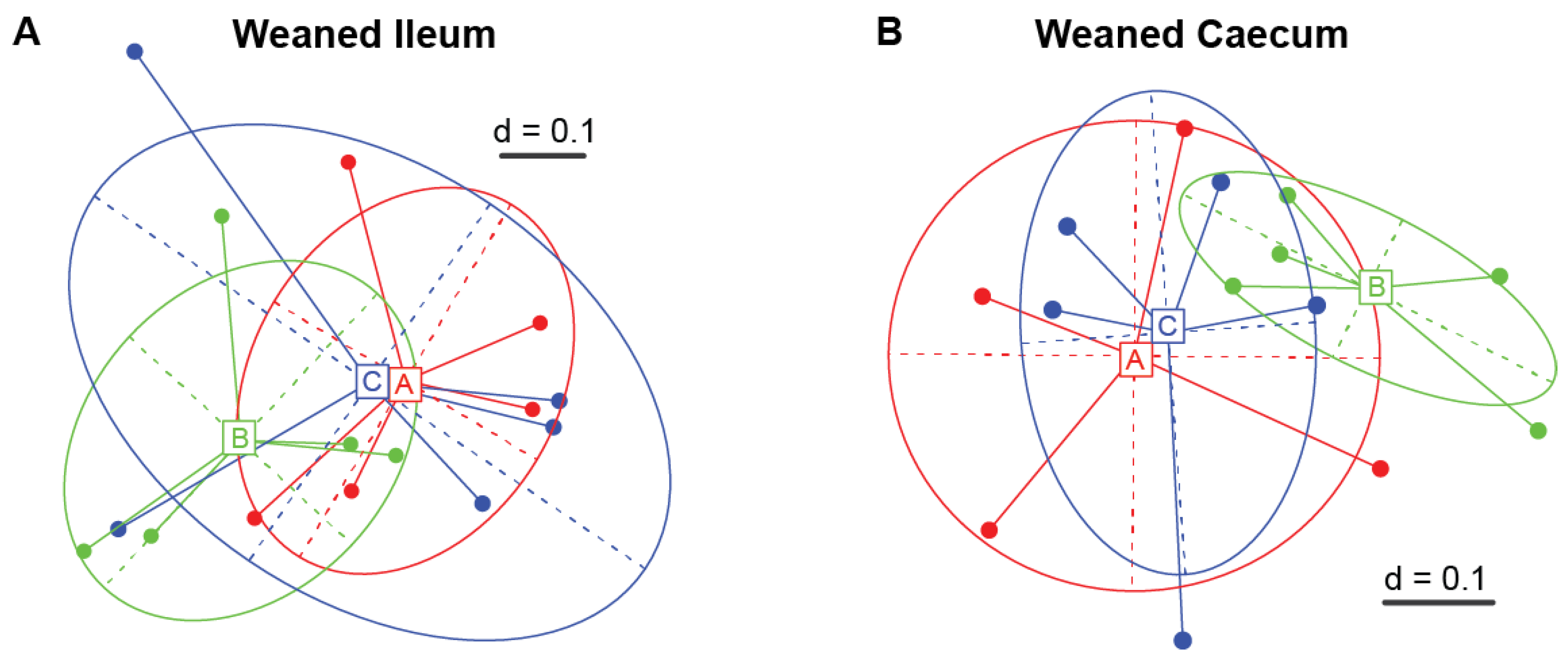
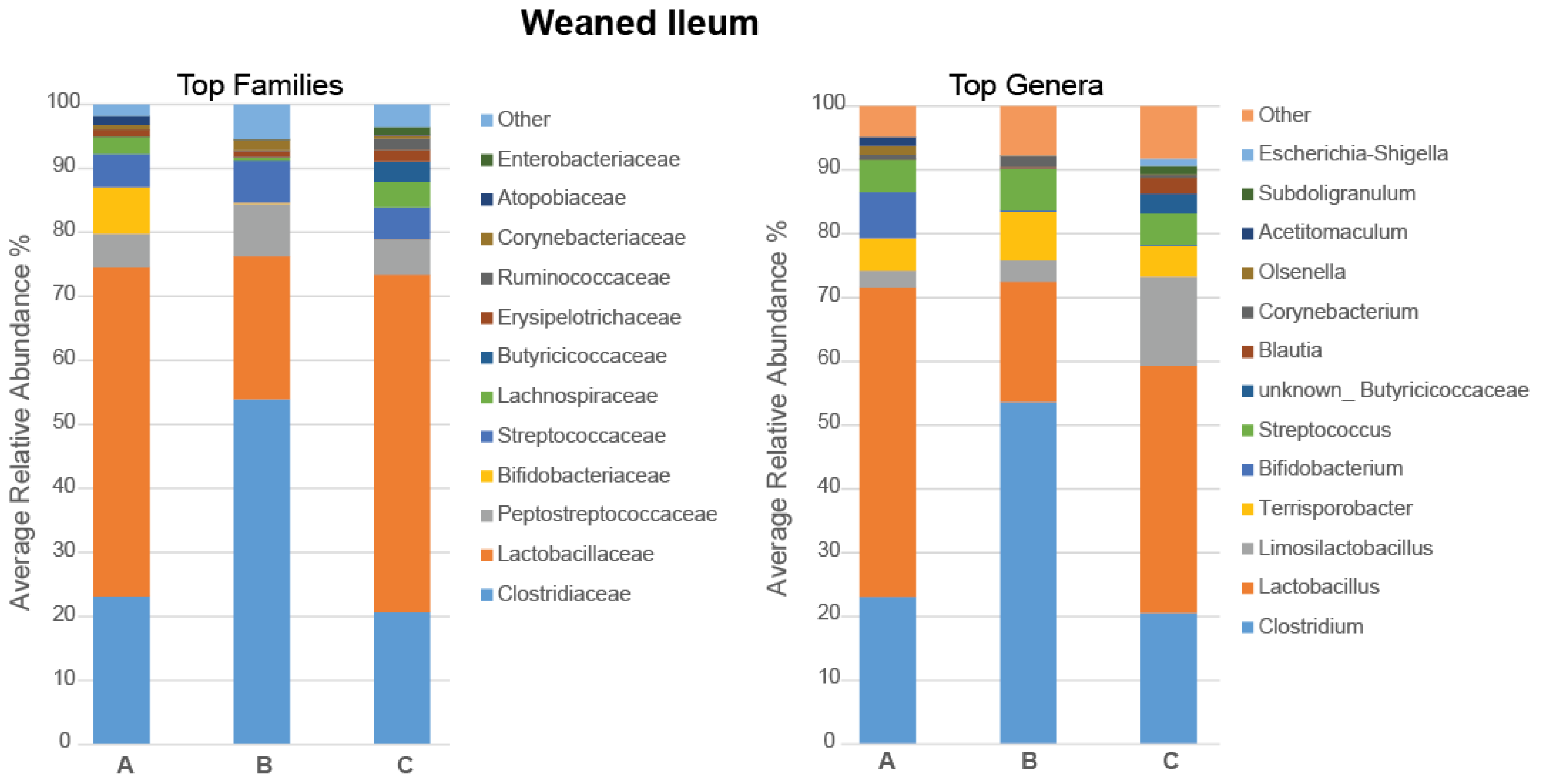
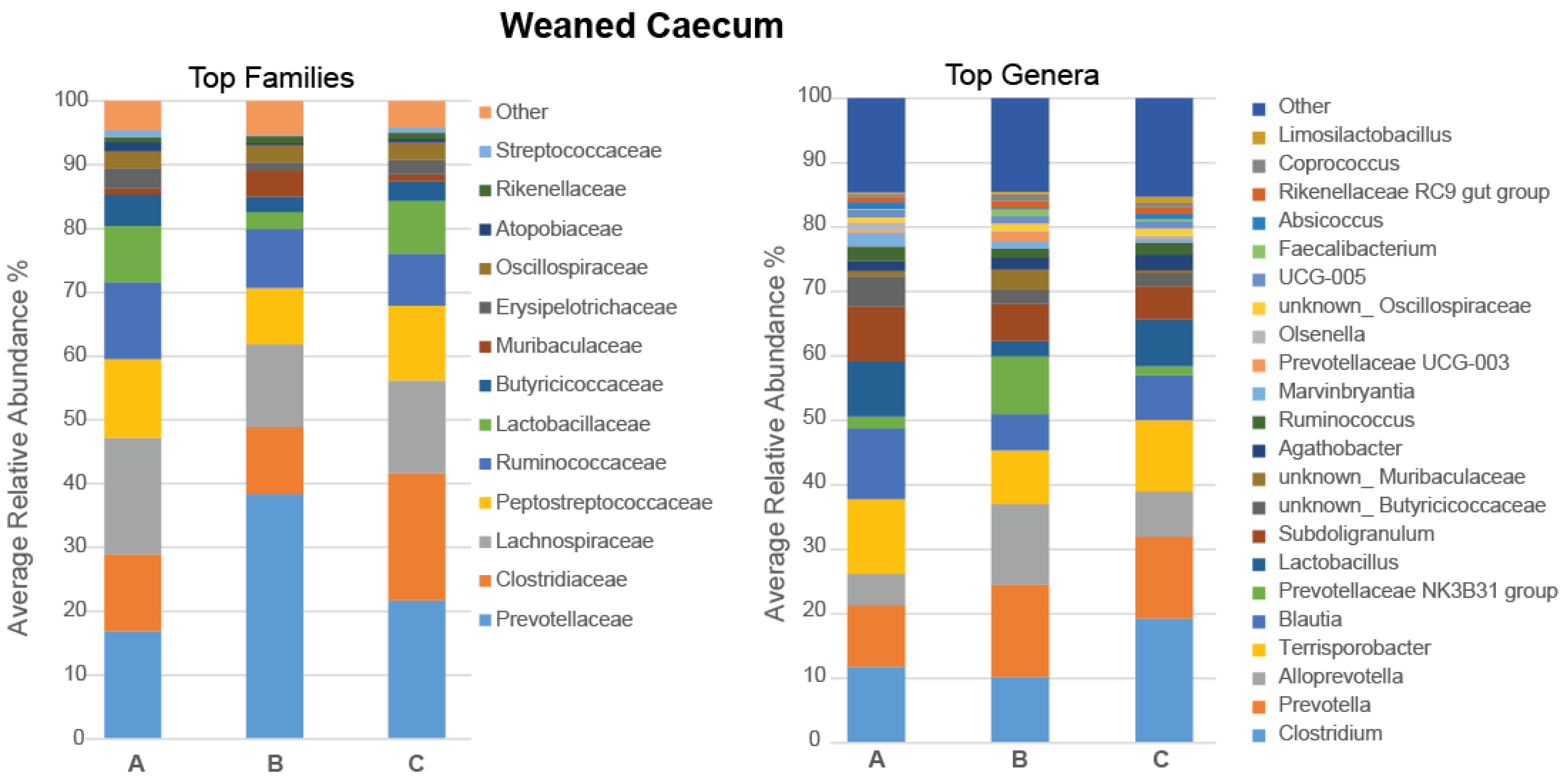
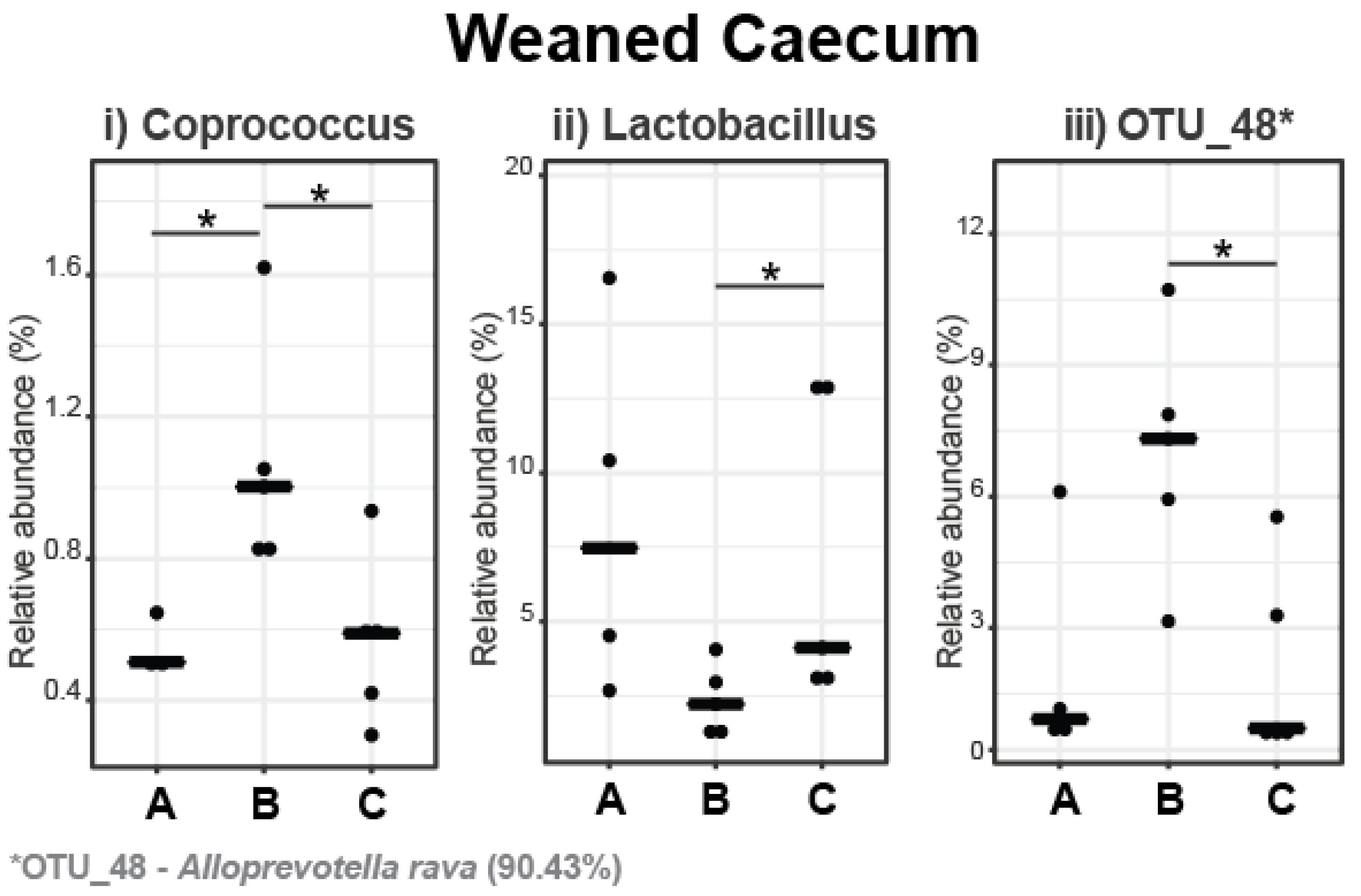

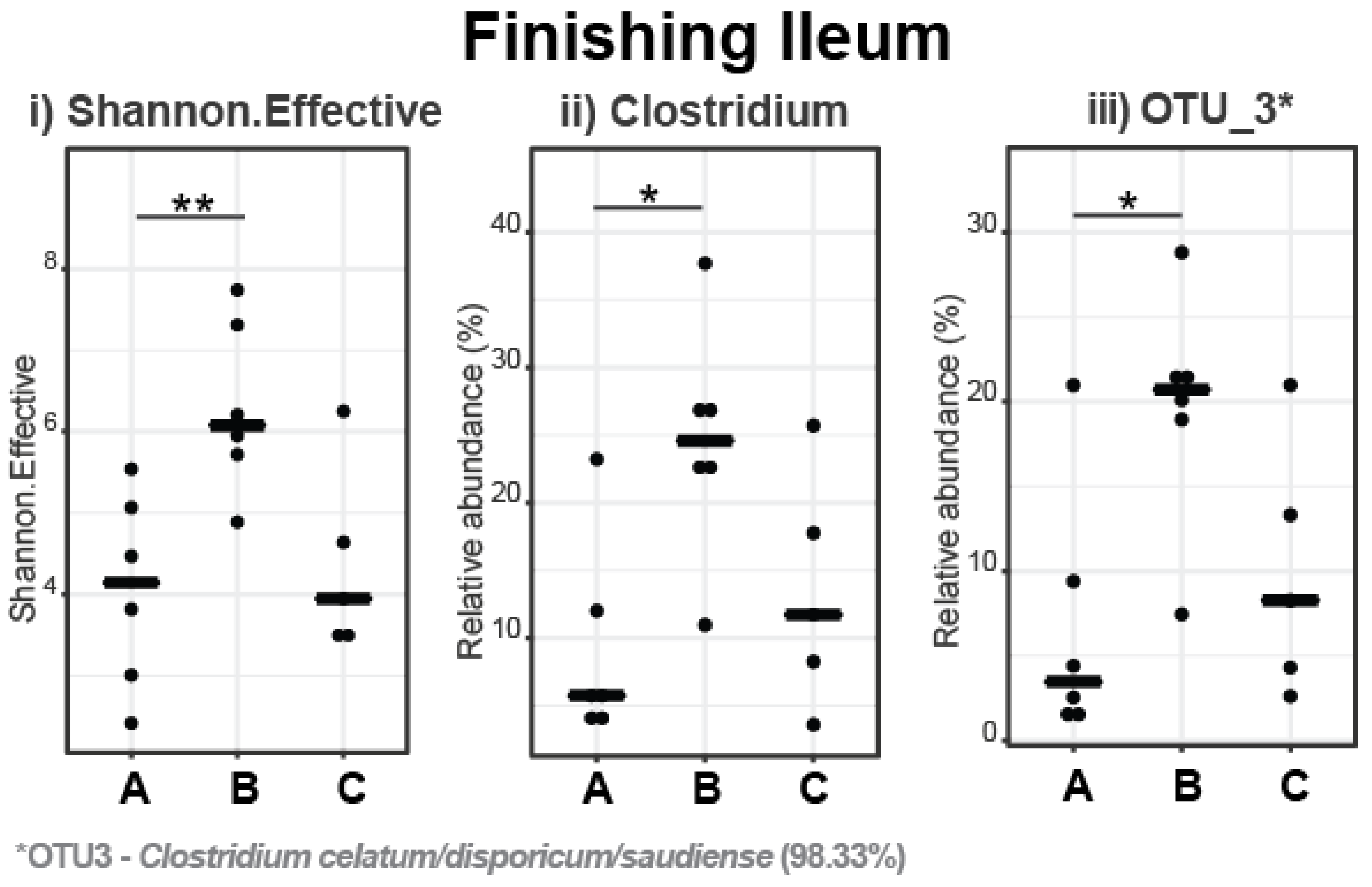
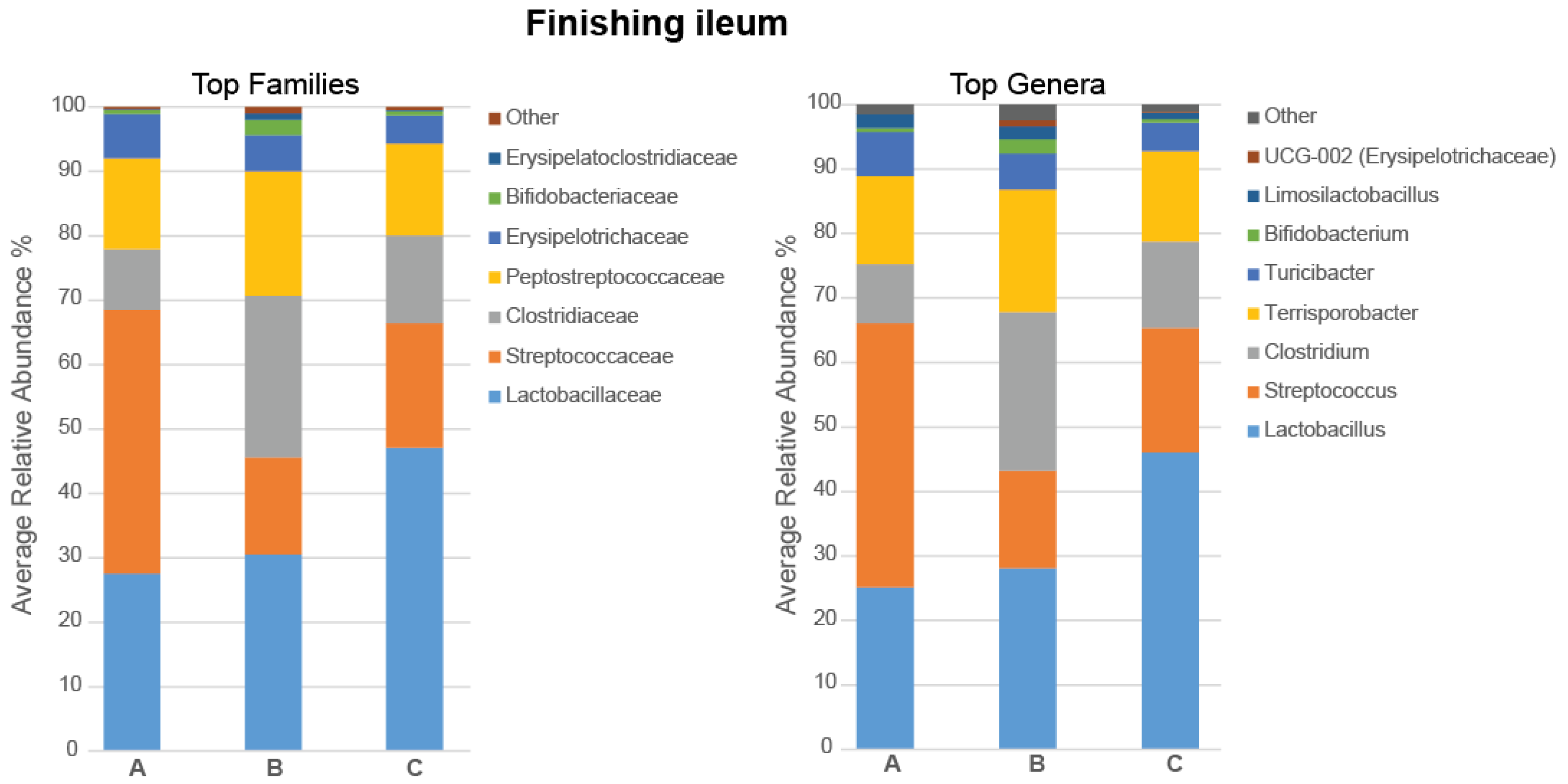
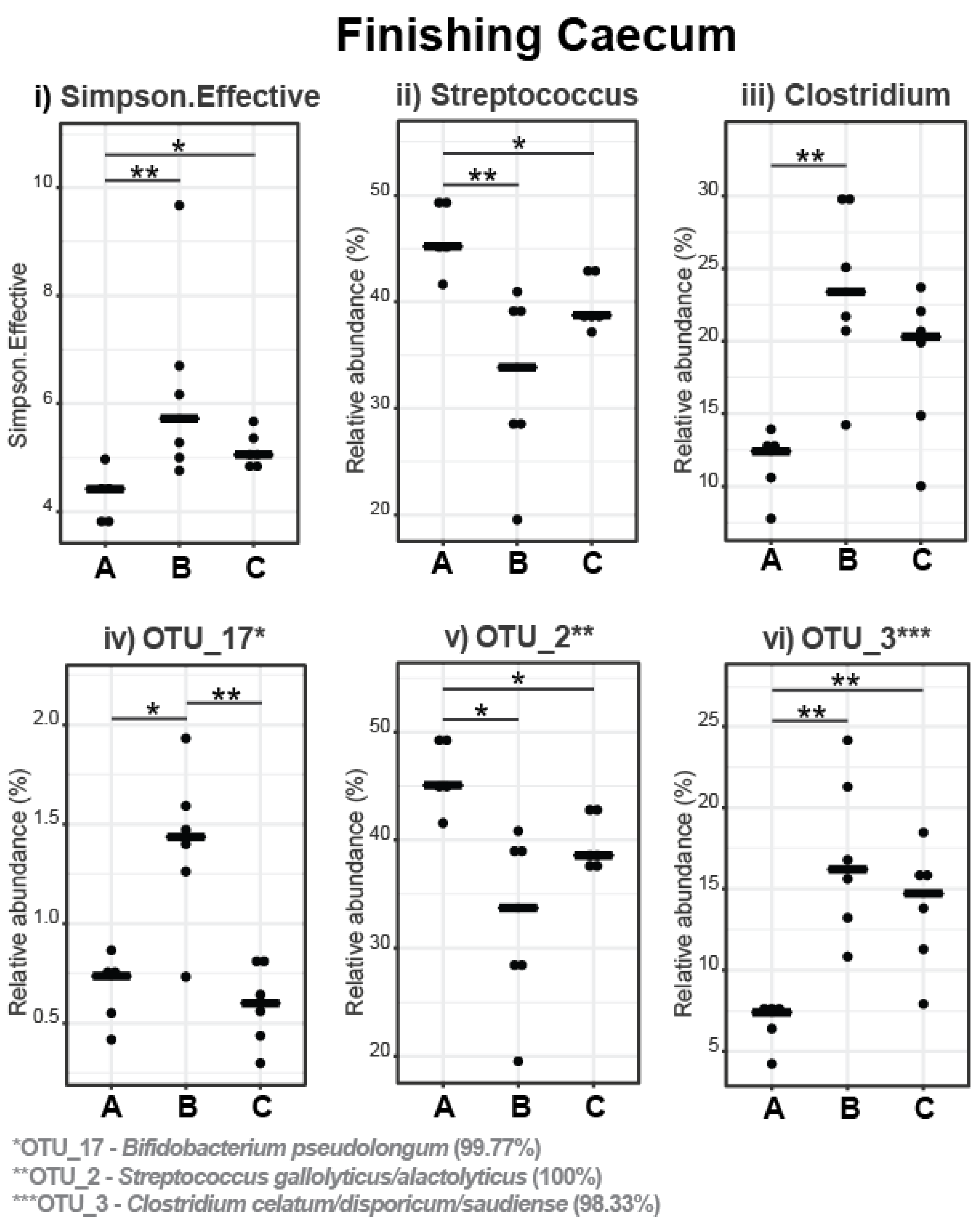
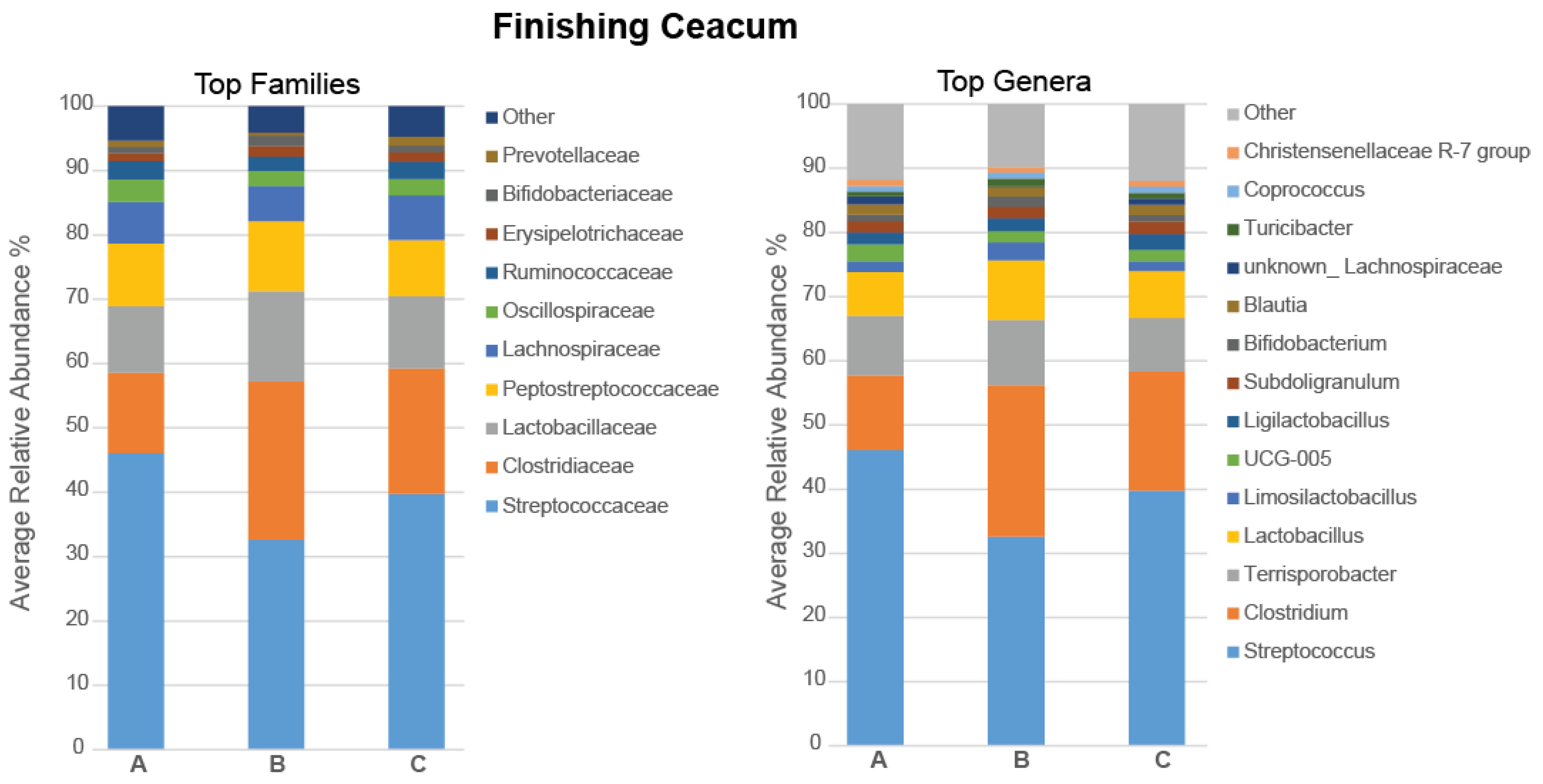
| Ingredient (%) | Weaned Pig Diets | ||
|---|---|---|---|
| Control | 5% IS | 10% IS | |
| Maize | 43.60 | 36.97 | 30.34 |
| Innovative Silage (IS) | 0.00 | 5.00 | 10.00 |
| Soybean meal (47% CP) | 15.80 | 16.37 | 16.94 |
| Barley | 20.00 | 20.00 | 20.00 |
| Fishmeal (62% CP) | 3.00 | 3.00 | 3.00 |
| Wheat middlings | 3.00 | 3.00 | 3.00 |
| Soybean oil | 2.00 | 3.06 | 4.12 |
| Minerals and vitamins premix * | 6.00 | 6.00 | 6.00 |
| Whey permeate (4.5% CP) | 6.00 | 6.00 | 6.00 |
| Zinc oxide | 0.30 | 0.30 | 0.30 |
| Benzoic acid | 0.30 | 0.30 | 0.30 |
| Chemical analysis (as fed basis) | |||
| Digestible energy, MJ/kg | 13.87 | 13.86 | 13.86 |
| Crude protein, % | 17.64 | 17.64 | 17.64 |
| Dry matter, % | 89.03 | 87.68 | 86.32 |
| Ash, % | 5.45 | 5.45 | 5.46 |
| Crude fat, % | 4.50 | 5.43 | 6.37 |
| Crude fibre, % | 2.90 | 2.86 | 2.82 |
| Acid detergent fibre, % | 3.30 | 3.26 | 3.22 |
| Neutral detergent fibre, % | 9.86 | 9.61 | 9.36 |
| Ca, % | 0.58 | 0.58 | 0.58 |
| Total P, % | 0.49 | 0.48 | 0.48 |
| Lysine, % | 1.18 | 1.19 | 1.19 |
| Methionine + Cystine, % | 0.74 | 0.74 | 0.73 |
| Ingredient (g/kg) | Finishing Pig Diets | ||
|---|---|---|---|
| Control | 5% IS | 10% IS | |
| Wheat | 45.00 | 37.45 | 30.05 |
| Innovative silage (IS) | 0.00 | 5.00 | 10.00 |
| Soybean meal (47% CP) | 14.00 | 15.60 | 17.10 |
| Barley | 27.60 | 27.60 | 27.60 |
| Wheat middlings | 9.50 | 9.50 | 9.50 |
| Soybean oil | 1.15 | 2.10 | 3.00 |
| Minerals and vitamins premix * | 1.00 | 1.00 | 1.00 |
| Booster supplement † | 0.25 | 0.25 | 0.25 |
| Salt | 0.50 | 0.50 | 0.50 |
| Limestone | 1.00 | 1.00 | 1.00 |
| Chemical analysis (as fed basis) | |||
| Digestible energy, MJ/kg | 13.34 | 13.34 | 13.34 |
| Crude protein, % | 16.55 | 16.75 | 16.95 |
| Dry matter, % | 87.68 | 86.33 | 84.98 |
| Ash, % | 4.56 | 4.57 | 4.58 |
| Crude fat, % | 2.43 | 3.38 | 4.33 |
| Crude fibre, % | 3.88 | 3.86 | 3.84 |
| Acid detergent fibre, % | 4.62 | 4.59 | 4.56 |
| Neutral detergent fibre, % | 13.65 | 13.45 | 13.24 |
| Ca, % | 0.57 | 0.57 | 0.57 |
| Total P, % | 0.39 | 0.39 | 0.39 |
| Lysine, % | 1.07 | 1.10 | 1.13 |
| Methionine + Cystine, % | 0.62 | 0.62 | 0.62 |
| Threonine, % | 0.75 | 0.76 | 0.78 |
| Tryptophan, % | 0.23 | 0.23 | 0.24 |
| Weaned Pigs (Exp. 1) | Control | 5% IS | 10% IS | SEM | p-Value |
|---|---|---|---|---|---|
| Initial body weight *, kg | 8.30 | 8.32 | 8.40 | 0.177 | 0.975 |
| Final body weight *, kg | 26.47 | 26.38 | 27.64 | 0.494 | 0.518 |
| Weight gain *, kg | 18.16 | 18.06 | 19.24 | 0.391 | 0.401 |
| Finishing pigs (Exp. 2) | |||||
| Initial body weight †, kg | 57.75 | 59.48 | 61.18 | 0.850 | 0.272 |
| Final body weight †, kg | 122.08 | 123.60 | 127.95 | 1.510 | 0.281 |
| Weight gain †, kg | 64.33 | 64.11 | 66.76 | 1.250 | 0.659 |
Disclaimer/Publisher’s Note: The statements, opinions and data contained in all publications are solely those of the individual author(s) and contributor(s) and not of MDPI and/or the editor(s). MDPI and/or the editor(s) disclaim responsibility for any injury to people or property resulting from any ideas, methods, instructions or products referred to in the content. |
© 2023 by the authors. Licensee MDPI, Basel, Switzerland. This article is an open access article distributed under the terms and conditions of the Creative Commons Attribution (CC BY) license (https://creativecommons.org/licenses/by/4.0/).
Share and Cite
Skoufos, I.; Nelli, A.; Venardou, B.; Lagkouvardos, I.; Giannenas, I.; Magklaras, G.; Zacharis, C.; Jin, L.; Wang, J.; Gouva, E.; et al. Use of an Innovative Silage of Agro-Industrial Waste By-Products in Pig Nutrition: A Pilot Study of Its Effects on the Pig Gastrointestinal Microbiota. Microorganisms 2023, 11, 1723. https://doi.org/10.3390/microorganisms11071723
Skoufos I, Nelli A, Venardou B, Lagkouvardos I, Giannenas I, Magklaras G, Zacharis C, Jin L, Wang J, Gouva E, et al. Use of an Innovative Silage of Agro-Industrial Waste By-Products in Pig Nutrition: A Pilot Study of Its Effects on the Pig Gastrointestinal Microbiota. Microorganisms. 2023; 11(7):1723. https://doi.org/10.3390/microorganisms11071723
Chicago/Turabian StyleSkoufos, Ioannis, Aikaterini Nelli, Brigkita Venardou, Ilias Lagkouvardos, Ilias Giannenas, Georgios Magklaras, Christos Zacharis, Lizhi Jin, Jin Wang, Evangelia Gouva, and et al. 2023. "Use of an Innovative Silage of Agro-Industrial Waste By-Products in Pig Nutrition: A Pilot Study of Its Effects on the Pig Gastrointestinal Microbiota" Microorganisms 11, no. 7: 1723. https://doi.org/10.3390/microorganisms11071723
APA StyleSkoufos, I., Nelli, A., Venardou, B., Lagkouvardos, I., Giannenas, I., Magklaras, G., Zacharis, C., Jin, L., Wang, J., Gouva, E., Skoufos, S., Bonos, E., & Tzora, A. (2023). Use of an Innovative Silage of Agro-Industrial Waste By-Products in Pig Nutrition: A Pilot Study of Its Effects on the Pig Gastrointestinal Microbiota. Microorganisms, 11(7), 1723. https://doi.org/10.3390/microorganisms11071723










